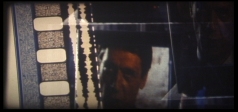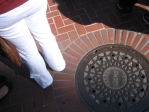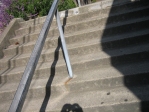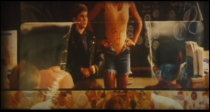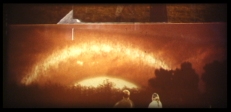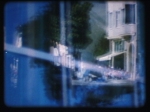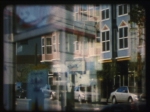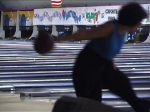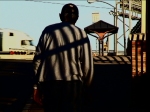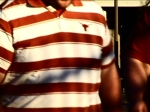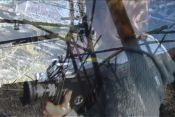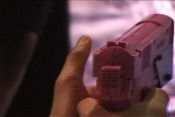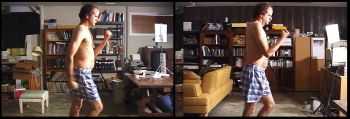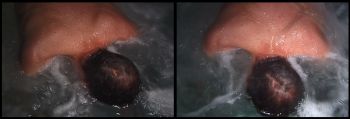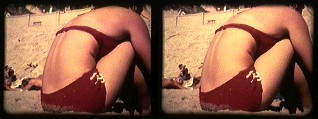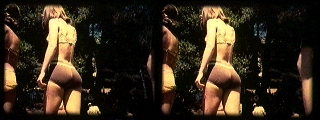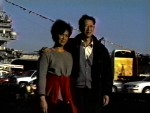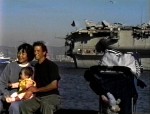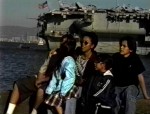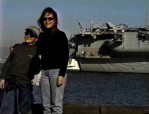Scott Stark
This page has been archived. Please visit www.scottstark.com for Scott's current web page. |
"I see each film/video project as a 'first film' with its own cinematic language, one that the viewer learns and engages with as the piece unfolds. This language is shaped by the particular mechanics of each medium, in the same way verbal language is shaped by the mechanics of the human mouth. Thus each film charts the possibility of a pre-cinema experience, one that might have evolved had not narrative and commerce been cinema's prevailing motivational forces." -- SS
Scott Stark (contact) has produced more than 60 films and videos since 1980. Additionally, he has created a number of gallery and non-gallery installations using film and video, and elaborate photographic collages using large grids of images. Born and educated in the midwest, he has always been interested in aggressively pushing his work beyond the threshold of traditional viewing expectations, challenging the audience to question its relationship to the cinematic process; yet he also tries to build into the work elements of humor and incongruity that allow the viewer an entryway into the work while maintaining a critical distance. Both a passionate purist and a cynical skeptic, he likes to emphasize the physicality of film while cross-referencing it to the world outside the theater, attempting to lay bare the paradoxes of modern culture and the magical nature of the perceptual experience.
Scott's films and videos have shown locally, nationally and internationally, including recent one person shows at New York's Museum of Modern Art and the Pacific Film Archive. His films have won several awards including four Black Maria awards, and he recently received a San Francisco Bay Guardian Goldie Award. In 2007 Scott received a Guggenheim Fellowship and a MacDowell Colony Fellowship. He has taught art classes at the San Francisco Art Institute (where he also received his MFA), interweaving non-traditional uses of film and video with a variety of art disciplines. Stark served for seven years on the board of the San Francisco Cinematheque, during which time, among many other things, he co-founded the Cinematheque's journal of film and media art, Cinematograph.
Scott has worked in a variety of motion picture media, including 8mm, super-8mm, 16mm and video. Several of his films introduced a novel technique where he ran movie film through a still camera, which, when projected, produces collage-like barrages of images and odd optically-generated soundtracks. He calls this series of films the Chromesthetic Response Series.
Scott makes his living as a computer programmer and support specialist for a large multi-national corporation. He currently lives in Austin, Texas. He is the author of the Flicker pages.
Selected films and videos of Scott Stark
- Traces 1-6
- One Way to Find Out
- Valencia
- Tenpin Arpeggio
- Compressive/Percussive
- Longhorn Tremolo
- Speechless
- Right
- More Than Meets the Eye: Remaking Jane Fonda
- More Than Meets the Eye: Epilog
- All About the Illusion
- Driven
- Shape Shift
- Mutable Commute
- Chop
- To Love or To Die
- The Tells
- Angel Beach
- SLOW
- Posers
- in.side.out
- NOEMA
- Back in the Saddle Again
- Archimedes' Screw
- Under a Blanket of Blue
- I'll Walk with God
- Unauthorized Access
- Acceleration
- Don't Even Think
- Tender Duplicity
- Episiotomy
- The Chromesthetic Response Series
- Chromesthetic Response
- The Sound of His Face
- Satrapy
- Protective Coloration
- W
Air- Hotel Cartograph
More Films and Videos (complete list)
Traces 1-6
(2012, 35mm film, color/sound, 7 mins.)
Worldly surfaces, shifting shadows and overlooked patterns: a series of short
35mm films generated from digital still images and printed onto movie film.
The top and bottom half of each image alternate in the projector gate, and
the images are arranged in a dizzying array of rhythms and patterns. The images
also bleed onto the optical soundtrack area of the film, generating their
own unexpected sounds.
Winner: best experimental animation, Ann Arbor Film Festival, 2012
One Way to Find Out
(2012, color/sound, 35mm film, 5 mins.)
Hand-printed sections from 35mm movie trailers create a chaotic and densely
layered retelling of Hollywood form. Loosely about desire, fear of coupling,
and the consequences of moving forward, with results both catastrophic and
ecstatic.
Valencia
(2011, color/silent, 16mm film, 6 mins.)
Reflections from storefront windows along San Francisco's Valencia and Mission
streets in late afternoon sun. Double-exposed.
Tenpin Arpeggio
(2012, digital video, color/sound/10 mins.)
Movements of bowlers in an American bowling alley form an arpeggio of sound
and image against backgrounds of abstraction and calls for civic engagement.
The hypnotic cutting threatens to break apart the frame, as if the bowlers
were attempting to free themselves from the restraints of their physical environment.
Compressive/Percussive

(2010, digital video, color/sound, two projectors, 18+ mins.)
Compressive/Percussive is a double-projector performance using two
digital video projectors. The imagery is taken from a double-decker interstate
freeway a few blocks from my current residence in Austin, Texas. At certain
times of the day, this monstrous structure, which years ago laid waste to
a thriving neighborhood and divided the city between the haves on the west
and the have-nots on the east, comes alive with a mesmerizing interplay of
light, shadow and rapidly moving vehicles. The sequences are all randomly
edited using a random sequence generator I developed for Final Cut Pro, with
cuts between 4 and 10 frames in length.
Longhorn Tremolo
(2010, digital video, color/sound, 17 mins.)
Excited football fans move through a visually kinetic space in slow
motion toward their goal.
Winner: First Prize Juror's Award, Black Maria Film Festival 2011
Speechless
Background info and photos
(adults 18 years and over only please).
(2008) 16mm film, color, sound, 13 mins.
Sound by Greg Headley.
Digital video version also available.
3D photographs of human vulvae are animated and interwoven with surfaces and textures from natural and human-made environments. The genital images were taken from a set of ViewMaster 3D reels that accompanied a textbook entitled The Clitoris, published in 1976 by two medical professionals. Background info and photos can be found on the Speechless page (adults 18 years and over only please).
Awards:
Grand prize winner: Black
Maria Film Festival (2009)
First prize (experimental): Chicago Underground Film Festival (2009)
First prize: Milwaukee Underground Film Festival (2009)
| Click
to read reviews of Speechless: >
"Speechless is gorgeous, mysterious, hallucinatory.... This is a magnificent work, equal to, or even better than, Brakhage's sexual meditations." -- Gene Youngblood, author of Expanded Cinema. "Speechless is a stunning piece, one that made me feel both uncomfortable and awed." -- Lynne Sachs "...the landscape textures, composition, and rhythm of the landscape layer really merged and created a meditative space for the power of the body, a part of the body that in all of its mystery has been sadly, sadly misunderstood and underacknowledged." -- Kerry Laitala "Just as NOEMA introduced the idea of 'seeing through' porn only to demonstrate its fundamental impossibility, Speechless is 'speechless' precisely because it is the greatest possible visual realization of an untenable metaphor.... Speechless renews the possibility of seeing natural forms, including vaginas, as having formal homologies the observation of which could (and does) yield astonishing beauty." -- Michael Sicinski, Views reviews 2008, Academic Hack. "A 13 minute work of considerable presence and intensity... In this illuminating form of things convolved, the pattern shared by vertically oriented prepuce and labia majora on the one hand, and a cluster of small rocks nestled between two larger rocks on the other, with playful self-consciousness seem to inject the very pulse of life into inanimate things: to put blood into a stone." Julie Murray, Within the Range of Normal, SNAPMilwaukee "...an ecstatic poem to the female genitals as the awe-inspiring, mythic symbol of the fertile, generative force in the universe." -- David Finkelstein, FilmThreat.com "By the time this movie ends, I suppose you could say that one is rendered speechless because all of the words and terminology of analysis have broken down into purely visceral experience, and now even the rote representation of vaginas has transcended its Freudian meaning and become something completely different, even though you're literally looking at medical images of them." -- Polaris_DIB, imdb.com "Corporeal topography. Organic homology. Retinal alchemy. Scott Stark's film, Speechless, insists on the integrity, the unity, and the fearsome beauty of organic form. After watching this film I truly felt as if I had re-lived the process of coming to consciousness. My wet lungs howl for the dark warmth of amniotic fluids and the white noise of placenta pumps. But Stark cuts the umbilical with his teeth, turns on the lights, and embeds me in inescapable terrain; moreover, by the end of the thirteen minute odyssey, we're no longer in need of assistance. We stand before these fearsomely radiant images with our own two feet." -- Cauleen Smith, Carousel Microcinema |
Background info and photos (adults 18 years and over only please).
Right
(2008, mini-dv, color/sound, 13 mins.)
A playful study of one of the U.S.A.'s most ubiquitous symbols, and an attempt
to re-invent it as a thing of problematic beauty. Overlayed on top of the
imagery are snippets of an email exchange I had with a person who was and
remains a staunch apologist for the Bush administration's hundreds of lies
leading up to the 2003 U.S. invasion of Iraq, as well as for the administration's
many other crimes, corruptions and failings.
"Stark, for his part, slices and dices this false idol, undermining [Mr. Right's] dead certainties with a fragmentation and multiplicity more in keeping with the existential facts of 21st century 'America.' But Right also demonstrates, once and for all, that the proper way to display the American flag is probably not at all." -- Michael Sicinski, Academic Hack
(The complete transcript of the exchange is available here.)
More Than Meets the Eye: Remaking Jane Fonda
(2001/2006, Hi-8mm tape, color/sound, 20mins.)
In the early 1980s, the celebrity actress/activist Jane Fonda, who was by
then known for her sharp anti-war statements and revolutionary idealism during
the Vietnam War, produced a series of exercise videotapes, in which she starred.
The videos became among the best selling videotapes of all time, and helped
usher in a cultural transformation from the communal and political thinking
of the 1960s and 70s to the me-decade of the 1980s. More Than Meets
the Eye: Remaking Jane Fonda is a remake of one of her exercise videos,
with myself as the performer, set in a variety of locations, both public and
private, that underscores a sense of supposed embarrassment I as a male might
feel by inhabiting what is essentially a feminine landscape. By overlaying
the diligent exercise imagery with provocative and pointed quotations from
Jane Fonda's activist days, as well as her thoughtful ruminations from her
recent autobiography on war, political transformation, female anxiety, and
the "need to be perfect," the remake gives voice to my own feelings
about the criminality of contemporary war-making and our own complicity in
a world that gives rise to a kind of cultural bulimia. In the process, the
video becomes an indirect chronicle of the remaking of a celebrity
activist and the cultural shifts that allowed it happen.
"Filmmaker Scott Stark takes a post-modern stance on celebrity activism and how cultural times can change a singular voice of dissent into suddenly being the leader of the Me Generation with More Than Meets the Eye: Remaking Jane Fonda. Stark himself is featured in various settings reenacting some of Jane Fonda's exercise videos, while the actress's own controversial ruminations on the Vietnam War scrolls across the screen, creating a highly conflicting juxtaposition of her role in both the '70s and '80s cultural movements." -- Jeremy Wheeler, All Movie Guide
"Stark took what was a compartively reductive work, and with a generosity of thought and an empathetic spirit, bravely opened it up to chart his own growth and thought processes. The sensibility is as infectious as the workout routine--viewers are encouraged to reexamine their own thoughts, as well as join in with the calisthenics." -- Chris Stults, Assistant Curator of Film/Video, Wexner Center for the Arts, Columbus, Ohio. Read the full article (PDF, 78KB).
"Finally among the image-reprocessors, we find Scott Stark, remaking his own earlier version of a remake of Jane Fonda’s best-selling workout tape (now available in its original form for $1 at Salvation Army stores coast to coast). Stark’s More Than Meets the Eye: Remaking Jane Fonda was, by the artist’s own admission, something of an indictment of Fonda in its previous form, an interrogation of how a vocal feminist and anti-war activist takes on a second life as a fitness guru. But, as Stark explains in his "Letter to Jane" (calling to mind, of course, Godard and Gorin’s cinematic excoriation of Fonda the Hollywood Radical), upon reading Fonda’s autobiography his viewpoint changed, seeing the later Fonda not necessarily as a “remake” or a betrayal but as a personal evolution, a way to understand female embodiment as a significant site for issues of patriarchal power and control of the sort that, in slightly different guises, carpet-bombs Hanoi, not to mention Kabul and Baghdad. Like the first More Than Meets the Eye, Stark tapes himself doing the Jane Fonda Workout in various public and private locations, a shrewd enough gender-reversal in itself. But in the new version, Stark includes Fonda’s own words as superimposed text, forming a running dialogue between multiple “Janes” that perhaps turn out to be more or less integrated and fully empowered. At first I wasn’t sure that these texts improved on Stark’s first edition, but MTMTE2 won me over to the cause. Stark is to be commended not only for his satirical acumen (the piece is hilarious) but also his willingness to revise himself, to make his own socialist-feminist retraction a matter of public record." -- Michael Sicinski, 2006 New York Film Festival 's VIEWS FROM THE AVANT-GARDE "sidebar"
Also read: My Letter to Jane
More Than Meets the Eye: Epilog
(2006, miniDV, color/sound, 7 mins.)
A companion to More Than Meets the Eye: Remaking Jane
Fonda, this brief epilog transposes the text of a 1970s Saturday
Evening Post reviewer's commentary about Jane Fonda over a point-of-view
shot of a jogger slogging across wet pavement. The text typifies the desperate
attempts by political commentators of the time to discredit Fonda's articulate
anti-war stance by any means necessary, including questioning her "femininity."
The point-of-view shot questions who the "I" in the commentary is;
the jogger? Am "I" complicit in this myopic and sexist viewpoint?
All About the Illusion
(2006, miniDV, color/sound, 8 mins.)
All About The Illusion uses two synchronized cameras, one pointing
forward and the other behind, to explore an abandoned train repair yard: a
site of industrial neglect, decay, toxicity and new growth. The journey also
becomes a shared experience of visual discovery with a close friend.
Driven
(2005, miniDV, color/sound, 10 mins.)
Driven attempts to blur the lines between video gaming and
reality, finding in both a seductive resonance.
Shape Shift
(2004, miniDV, color/sound, 10 mins.)
A simple technique with two opposing cameras reveals a body transposed upon
itself, confounding the limits of its own physical space..
"Scott Stark's Shape Shift employs a devious editing device that thoroughly destroys our sense of physical integrity. What is the artist's body? A fixed resource poised for delivery? Or a plastic volume for easy reinvention?" - Steve Seid, Pacific Film Archive
"Relaxing repeatedly, from one angle and its opposite, mirroring actions and sounds, testing textures and mashing them altogether in a fuck-all barrage of lonesome symmetry, Stark captures the moments within each moment in an echo-cham-ber peek into a day in the life of a reticent exhibitionist." -- Riley O'Bryan, Cinematexas
"Stark has produced another droll, rigorous winner." Michael Sicinski, The Academic Hack.
Mutable Commute
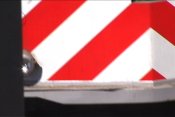


(2001/2003, miniDV, color/sound, 30 mins.)
Mutable Commute is an abstracted evocation of the body in transit,
its strengths and vulnerabilities, and the harsh permeability of the machines
and buildings that transport the body through, and contain it within, the
urban environment. Mutable Commute also explores the cyclical nature
of human survival as workers inhabit the quiet sterility of their offices
and other public spaces, performing cyborgian movements which are part physical,
part cerebral, part mechanical, and part digital.
The segments in Suite for VCRs on each video cassette were edited in one of two ways. The first is what I call a "progressive loop," where the clip is repeated a number of times, but the beginning and ending points of the clip move forward a couple of frames at each iteration. Therefore most of the image is repeated, but it changes slightly as the beginning of the clip gets chopped off and a few frames get added at the end. This allows the viewer to key into the internal rhythm of the clip, while watching it grow and evolve into something else. The second editing technique uses a random video editing program, which I created on the computer for this project. It reads a list of video clips and reassembles them randomly into a sequence which seems oddly outside the realm of human intention.
Mutable Commute is performed using three VCRs and three monitors, where the performer inserts tapes in a partly random matter to make the sounds and images play with and against each other. The piece is also available as a single channel video, which lasts about 30 minutes.
Chop

(2003, miniDV, color/sound, 5 mins.)
An insomnolent, self-mutilating, hydrophobic rendering of physical
and emotional anxiety.
To Love or To Die

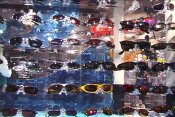
(2003, miniDV, color/sound, 5 mins.)
Made with two parallel cameras, To Love or To Die is a brief
binocular odyssey through a suburban wonderland of desire and fulfillment.
"Stark wanders through a mall with two camcorders, creating an oscillating image that amplifies the schizophrenic self-negation of the desiring-machine." -- Images Festival, Toronto
The Tells
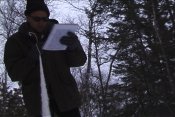

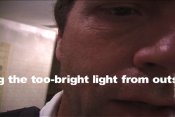
(2002, miniDV, color/sound, 20 mins.)
Written, photographed and edited by Scott Stark Based on a collection of dense,
enigmatic prose, read to the camera in a variety of public and private settings,
and later re-processed through editing and visual manipulation, The Tells
uses dense overlays and rhythmic distractions to pull teasingly at the scattered
threads of personal soliloquy. The result is a furtive attempt to locate a
resilience of individual spirit within the strictures of environmental, technological
and informational overload. In six parts.
Angel Beach
|
|
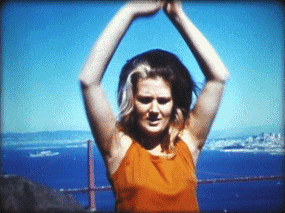
click for more animations |
(2001, 16mm color, 18fps, silent, 27 mins.)
Anonymous 3D photographs of bikini-clad women from the early 1970s are compressed
into a two-dimensional cinematic space, triggering an exuberant visual dance
and revealing a troubling and elegiac voyeurism.
"Incarnations: free spirits take physical form in young mortal bodies on northern California beaches. Their initial movements are mere flittering gestures and awkward extensions of elbows, knees and shoulders : these are innocents unused to the strictures of the human form, joyful in the wonderment of first physical sensation. Freshly sprung from the ethereal chrysalis, they set to work, busily burrowing and crafting three dimensional baffles, channels and passageways through a screenspace that is too shallow to contain their neophytic exuberance." - s.s.
"Scott Stark's Angel Beach was easily the most accomplished and satisfying film in the five [New York Film Festival/Views from the Avant Garde] programs... [It] occupies a fascinating position, somewhere between documentary (inviting us to scour the images for clues as to their origins) and extremely voyeuristic spectacle." One of the top ten films of 2001 (list) -- Nicole Armour, Film Comment
"The intensely hypnotic Angel Beach was created from stereoscopic photographs of people on the beach circa 1970. Filmmaker Scott Stark intercuts the stereo images so rapidly that objects appear to vibrate around a static point..." - Fred Camper, Chicago Reader
"[An] especially notable film was Scott Stark's Angel Beach... By oscillating rapidly between the two images, he produces a strange simulation of three-dimensionality: the centered subjects leap out of the screen, literally vibrating with libidinal energy, while the intensely pulsating backgrounds veer toward semi-abstraction. The girls' awkward poses produce some peculiar and interesting effects. But most impressive of all is the illusion of continuous motion Stark produces by cutting between two separate sets of images. The distinct sensation of circling around a stationary subject, while never actually changing position is profoundly disorienting." - Brian Frye, indieWIRE review of 2001 New York Film Festival Views from the Avant Garde
"Watching this piece makes you feel like you are sitting in a giant, slightly naughty, washing machine with the agitator swishing you back and forth while you gawk at gyrating flesh; it is a disorienting effect to say the least." -- Stephanie Beasley, The Austinist
"An exhilarating celebration of eyeballs aroused." -- David Finkelstein, filmthreat.com
Angel Beach was accepted into the 2002
Whitney Biennial.
SLOW


 |
(2001, MiniDV, color/sound, 16 mins.)
SLOW uses a simple cinematic device -- the wipe -- to interweave human and
mechanical movements through fixed spaces over time, revealing potent absences
and reflected presences.
"An utterly prescient and fascinating portrait of urban space and our increasingly common experience of fragmentation." -- Holly Willis, LA Weekly
"[Slow] is one of those films that cuts up pieces of ordinary reality and arranges them into regular rhythmical patterns, giving them the appeal of music. This is a technique that I've always loved when it is well done, and here it is very well done indeed.... The appealing waltz-like rhythm of "Slow," through repetition, makes the rhythms inherent in ordinary scenes jump out at us, and enhances our ability to appreciate and enjoy their dynamic qualities." -- David Finkelstein, FilmThreat.com
"The slashing movement of mechanized wipes acts as a magic wand morphing surfaces and hyphenating time and space. In these rythymic vanishing acts and nuptial comminglings presence and absence buoy on the surface of liquid relations.The world emerges with a new set of intermingled alloys gasping for breath but integral within an ideal confusion." -- Mark McElhatten, International Film Festival Rotterdam
Best of 2001 (list) -- Gavin Smith, Editor, Film Comment
Posers
(2000) hi-8 videotape, color, sound, 12 mins.
A diverse stream of tourists and passers-by on San Francisco's waterfront
casually superimpose themselves against a benign backdrop of
U.S. military might. The video camera tries to replicate the invisible frame
that the subjects create around themselves as they assume, for a heightened
moment, the image of themselves they wish others to see. The notion of the
off-screen action to which they are responding -- the photographer taking
their picture -- is echoed in the shadow of the mammoth war machine
behind them, whose actions are, for most of us, perpetually "off-screen."
in.side.out
(1999) videotape, color, sound, 10 mins.
in.side.out is a very personal piece. On the surface it's about
the changes taking place, over a two-year period, in an empty lot and a decrepit
old building next to my house. Deeper down it's about the walls and windows
between my interior and exterior selves, and how the fragile constructs of
identity are etched, eroded, re-shaped and transformed by outside forces.
"Setting in motion the fixity and confinement of home against the transformation and liberation of an adjacent tract, Stark rhymes gesture across time and space." -- New York Video Festival
"An acutely edited structural film." Amy Taubin, Village Voice
NOEMA
(1998) videotape (16mm film version also available), color, sound,
11 mins.
NOEMA is philosopher Husserl's term for "the meaning of an object that
is formed in the domain of consciousness." Pornographic videos are mined
for the unerotic moments between moments, when the actors are engaging in
an awkward change of position or when the camera pans meaningfully away from
the urgent mechanisms of sex up to a cheap painting on the wall or the distant
embers of a crackling fire. A piercing musical score loops endlessly throughout,
and the repetitive and curious iterations of movement become furtive searches
for meaning within their own blandness.
"A canny, meticulous reduction of found video porn to raw motion study... Scott Stark finds in the busy-ness of the naked, often disembodied shapes of bodies a rhythm and finally a grace." -- Edward E. Crouse, San Francisco Bay Guardian.
"Scott Stark's Noema... deconstruct[s] a swatch of hard core pornography involving several couples. But instead of finding a hidden psychological subtext, he finds a psychological and erotic blankness in couplings that are never completed." -- Stephen Holden, New York Times.
"Stark uses repetition to choreograph remarkably beautiful sequences of bodily maneuvers as the actors shift position. A penis gets in the way here, a leg has to be pushed down there -- the mechanics of it all make for abstract visual poetry." -- Holly Willis, LA Weekly
"Noema is neither Boogie Nights nor the nights of Scheherezade, but more a Decameron-like tournament of missing links and coitus interuptus. A dizzy daisy chain of synchronized decouplings and eager hesitations where bodies never merge. Porno unplugged. In this skeleton dance of surplus motion the transitional moments of awkward repositioning create a multiple oasis of non sequtir and practical inconvenience.The editing constructs an exaggerated mechanics out of flawed maneuvers allowing anatomies to rotisserie with equestrian grace.The impaired visual intelligence, the unmotivated and lazy drift of the camerwork thirsty for insignificance and the defaulted mise en scene of the original source material asserts its deficiency and negative allure as it is brought to the point of a nearly redemptive desperation. Stark's analytical insistence pits his passionate acuity against dispassionate executions while giving the found material a sporting chance towards atomized immortality and ritual replay. A splayed adagio infects the scenes with a polar melancholy." -- Mark McElhatten, New York Film Festival
"The fact that Scott Stark has given the title NOEMA to a film comprised of looped fragments of video pornography might seem incongruous at first. But the film’s means have a specific historical relationship to questions of perception, intention, and the problem of idealism vs. materialism. But more importantly, NOEMA confronts an ethical dilemma which has shadowed a certain strain of modernism, particularly in cinema." -- Michael Sicinski, from Unbracketing Motion Study: Scott Stark’s NOEMA, in the anthology Porn Studies (Linda Williams, ed., Duke University Press, 2004)
Back in the Saddle Again
(1997) 16mm film, black & white, sound, 10 mins.
A found footage film that innocently plays with many of the elements I explore
in my own work. A family's playful interaction with a 16mm sound movie camera,
singing along as a group with Gene Autrey's title song in front of the camera,
combines western fantasy, American kitsch, gender posturing, deterioration
of the film's surface, the wonderment of the cinematic process, and the use
of controlled accidents to shape the form of the film. My only intrusion on
the footage was to print it first in negative, which adds a mysterious, ghostly
edge to it, and to print it again in positive, which seems to answer many
of the questions raised in the first version.
Archimedes' Screw
(1996), Hi-8 videotape, color, sound, 15 mins.
The final installment of the trilogy that includes I'll Walk
with God (1994) and Acceleration (1993). Cross-referencing
early 20th century women's histories with iconized models of Christian indoctrination,
and using a modern billboard as a point of departure, Archimedes' Screw
playfully distills and reconfigures contemporary notions of spirituality and
public vs. private identity. As the documentary-style structure of the video
begins to unravel and the personal histories become increasingly implausible,
the women portrayed become unwitting participants in an iconography of worship
and idealized femininity, unfairly transformed into corporate commodities
by the banality of the public sphere. Undermining its own narrative authority,
Archimedes' Screw gently evokes a sense of displaced and re-placed
sanctification.
Under a Blanket of Blue
(1996), Super-8mm film, color, sound, 15 mins.
A super-8 alchemy of song and imposing urban landscapes. Filmed in
heavily over-developed areas of northern and central Spain, the dehumanizing
and impersonal architectural structures that the inhabitants call "home"
are edited into a bittersweet array of rigid geometric forms and bland textures.
Ironically grafted onto the imagery is Glenn Miller's sweet romantic ballad,
"Under a Blanket of Blue," both in original recording and in a breathless
vocal a capella by the maker during the filming.
I'll Walk with God


(1994), 16mm color sound film, 8:00
Using emergency information cards surreptitiously lifted from the
backs of airline seats, I'll Walk with God pictorially charts an airline
flight attendant's stoic transcendence through and beyond worldly adversity.
Through an elaborate system of posturing and nuance that evokes an almost
ritualistic synergy, the female protagonist(s) are shuttled toward a higher
spiritual plane, carried aloft on the shimmering wings of Mario Lanza's soaring
tremolo.
Winner: First Prize (Director's Choice), Black Maria Film Festival, 1995
"With the silence for the first half, and the horrifying images, banal and tragic, sweeping through the screen of the airplane crash cards, and then the Mario Lanza track erupting on the sound level, the film summed up the ephemerality of human existence, our collective wish to remain immortal, the impossibility of this... it's a deeply felt, deeply moving film." -- Wheeler Winston Dixon
"As with many of his films Scott Stark is able to approach the ornaments and artifacts of mundane experience and conventional thinking to reveal both basic truths and shielded arcana. With an intelligence and imagination as piercing as it is deadpan, Stark never simply transforms the ordinary into the simply marvelous or the simply absurd. Rather he keeps the balance on an even keel through formal distillation and allowing disassimilations that open our eyes to the strangeness of the commonplace - and to humans as both keen and blunt receivers of mixed signals." -- Mark McElhatten, from nijinsky wept
notes on I'll Walk with God:
- nijinsky wept by Mark McElhatten
- flight-simulator-simulation-simulated by Luis Recoder
Unauthorized Access



(1993), color sound hi-8mm videotape, 30 mins.
An urban sabotage video in the highly structured and territorial world
of the financial services industry. Barriers are broken, trespass is the means
to transcend privilege, property and perspective.
Winner: Second Prize (Jurors' Choice), Black Maria Film Festival,
1994
Honorable Mention, film+arc Film & Architecture Film Festival, Austria
Acceleration



(1993), Super-8 color sound, 10 mins.
A snapshot taken in a moment of human evolution, where the souls of
the living are reflected in the windows of passing trains. The camera captures
the reflections of passengers in the train windows as the trains enter and
leave the station, and the movement creates a stroboscopic flickering effect
that magically exploits the pure sensuality of the moving image.
Winner: First Prize (Director's Choice), Black Maria Film Festival, 1994
Don't Even Think


(1992), super-8 color sound film, 15 mins.
Tongues flapping, lips smacking, teeth clacking, vocal chords vibrating;
it sounds like speech, but it's in a language where intellect and vocabulary
impede comprehension. To really hear what's being said, don't talk; don't
even think.
Tender Duplicity



(1992), color, sound, 35 mins.
Objects of aggression are suggestively fashioned from sensuous playthings,
inviting the viewer to indulge in the prurient pleasures of patriotism and
self-righteous hostility. The objects combine and juxtapose to form a seductive
visual catalog of the vocabulary of war, garlic-pressed through a lattice-work
of light and sound on the film's emulsion. As the tension builds between the
objects in front of the camera and the activity on the surface of the film,
a complex musical architecture is triggered across constantly shifting foregrounds
and backgrounds, activating incongruous polarities between figure and ground,
sound and image, pleasure and aggression, clarity and purposeful obfuscation.
The film was shot with an antique camera that records an optical soundtrack directly on the film while shooting. The footage was then systematically fogged and flashed with segments of white light, which caused both the image and sound to be erased; thus the flashes of light that appear in the film are followed one second later by a dropout of equal duration in the sound. The points between flashes (gaps), as well as the gaps themselves, become syllables of a language that is all but oblivious to the relentless posturing of the photographed images.
Episiotomy



(1990), Super-8 color sound, 13 mins.
This Super-8mm film was shot off of a French soft-core pornographic
comic book, against a variety of urban backgrounds in both France and the
USA. The sounds of those environments intrude upon the pictures, sometimes
enhancing and sometimes subeverting the narrative. I was interested in telling
a story, but devising a narrative structure to the film that was unrelated
to the story. Thus the rhythm and cadence of the narrative runs obscured somewhere
beneath the surface of the film's mechanics.
By using in-camera editing, contradictory juxtapositions of image and sound, and a variety of backdrops, physical forces and arbitrary events, the two narrative threads interweave and occasionally intersect, creating moments of dramatic punctuation which are mostly accidental. Oddly enough, the story itself, though it is diminished, disrupted and often ignored by the film's narrative structure, still seems to evoke a logical continuity; and despite all the distractions and activity around the edges of the frame, one's attention is still drawn toward the "events" represented on those flimsy pieces of paper.
The Chromesthetic Response Series
The following four films were made by shooting 16mm film in a 35mm still camera. Each of the four consists of a succession of 35mm still images which flicker, collage-like, through the 16mm projector gate, and because the images spill over onto the optical soundtrack area of the film, the variations in image density actually generate their own peculiar sounds. For example, pictures of zebras (in Protective Coloration) create a succession of odd musical notes.
Chromesthetic Response

(1987), color, sound, 5 mins.
A collage of human-created worldly surfaces -- sidewalks, streets,
storefronts -- that evoke subtle and mysterious noises. "Chromesthesia"
is a condition whereby one sees a color or shape and experiences a sensation
of taste, smell or hearing.
The Sound of His Face


(1988), color, sound, 5 mins.
A "filmed biography" of Kirk Douglas -- literally. Pages
of a book -- the lines of text, and the tiny dots comprising the half-tone
photographs -- create odd musical notes, which are edited into a pounding
rhythm. This film examines the molecular fabric of Hollywood superficiality.
Winner: Juror's Choice, SFAI Film Festival, 1988
Satrapy


(1988), color, sound, 13 mins.
Rephotographed pornographic playing cards rhythmically intrude upon
a piercing 5-beat score of different-sized black parallel lines, injecting
a note of "negative sound" every third beat against the 5-beat background.
As the film progresses, contrapuntal variations of 3, 4, 5 and 7 beat rhythms
blend and collide, creating an almost indiscernible complexity, until the
lined background ruptures and the sounds and visuals become scattered and
disordered. The "girlie" cards break out onto saturated color fields
and eventually find their way into the real world, aggressively flickering
by against backgrounds of earth, concrete and other surfaces.
"Scott Stark's Satrapy charts the subversive power of the feminine... Initially the alternation between the flickering cards -- with their teasing bare flesh -- and the stripes recalls subliminal perception tests. With more rapid, wildly anarchic editing, however, the cards displace the stripes, challenging the film's coherency. Female sexuality, instead of supporting the logic of representation, threatens annihilation." -- Manohla Dargis, Village Voice.
Winner: Honorable Mention, Oberhausen Film Festival, 1989
Protective Coloration
(1990), color, sound, 17:30.
In general the title "Protective Coloration" refers to zebras'
and other animals' fur patterns, which evolved naturally as camouflage to
allow them to hide from predators. The irony is that it is these same patterns
which make the animals more visible to human predators, since humans are,
unlike most other animals, attracted to their visual uniqueness. What evolved
to hide now serves to attract, especially when the animals are transplanted
from their natural habitat. This is a concept that exemplifies ways modern
humanity's relationship to the natural world.
The film is a succession of visual and aural "notes" generated by the patterns in the animals' hides, which are arranged and re-edited into a complex musical architecture, developing intricate rhythms not unlike the complex syncopations found in traditional African music. Elements of sand, dirt, light and shadow cross-reference the film's emulsion with evolutionary history, and provide a second level of musical structuring through which the first layer is necessarily filtered.
W
(1988), 3 super-8 films, color, sound, 25 mins.
A soaring, lilting, plunging excursion through a range of human experience.
Three films shown simultaneously overlap and create structures, shapes and
sounds not possible in the physical world.
Air
(1986), 16mm, color, silent, 9:00.
Shot in an airline terminal, Air studies the movements across
and through the planes of the film's surface. An obsessive geometric structure
is formed with camera angles and tracking shots.
Hotel Cartograph

(1983), 16mm, color, sound, 11:00.
A camera mounted on a movable cart, pointing down at the floor, passes
over a seemingly endless succession of gaudy carpets and surfaces in a single
shot through a major hotel. The movements across the 2-dimensional space,
and in and out of elevators through 3-dimensional space, suggest a conceptual
map of the visible environment, which is perhaps drawn by the camera itself.
Corporate Accounting
(1982), 16mm, B/W, sound, 6:00.
Made without a camera, using rolls of microfilm of thousands of cancelled checks "borrowed" from a major corporation, contact printed onto 16mm movie film. The sound is generated optically by the checks overlapping onto the soundtrack area of the film.
More Films and Videos (complete list)
One Person Film/Video Shows: Museum of Modern Art (New York), Lux Film Centre (London, England)Austria Filmmakers Cooperative (Vienna), Image Forum (Tokyo, Japan), El Independiente (Buenos Aires, Argentina), Filmforum (Los Angeles), San Francisco Cinematheque (San Francisco), Pacific Film Archive (Berkeley, California), Chicago Filmmakers (Illinois), First Person Cinema (Boulder, Colorado), Robert Beck Memorial Cinema (New York), Millennium (New York), Collective for Living Cinema (New York); Eiga Arts (Saga City, Japan); S.F. Camerawork Gallery (San Francisco).
Festivals, Group Shows: Oberhausen Film Festival (Berlin), New York Film Festival, Viper Film Festival (Switzerland), San Francisco International Film Festival, Stuch (Belgium), film+architecture Festival (Austria), Telluride International Experimental Cinema Expo (Telluride, Colorado), Onion City Film Festival (Chicago), London Film Festival (England), Film Arts Festival (USA), Black Maria Film Festival (USA), Utah Film & Video Festival (USA), New American Makers (San Francisco), Exploratorium (San Francisco), Other Cinema (San Francisco), Conspiracies (New York), El Paso Museum of Art (El Paso, Texas), Media Gallery (San Francisco), Intersection Gallery (San Francisco), SFAI Film Festival (San Francisco), Eye Gallery (San Francisco), ...
Also see Scott Stark's Complete Filmography and Flicker biography
Interviews, Articles
vector interview by Ana Boa-Ventura
stretcher interview by Dale Hoyt
[
r e a d m e ] interview by David Heatley
haciendo
cine (Argentina) interview by Pablo Udenio (in Spanish/en
español) (english)
San Francisco Bay Guardian Goldie Award
nijinsky wept: notes on I'll Walk
with God by Mark McElhatten
flight-simulator-simulation-simulated:
notes on I'll Walk with God by Luis Recoder
Distribution
Films available through Canyon Cinema or directly from the artist.
Contact
Bio Selected Filmography Interviews, Articles Complete Filmography Distribution Contact
